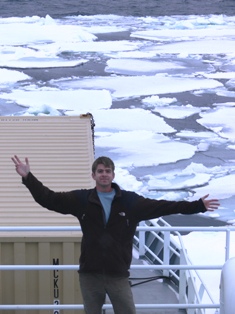
It’s early June, and there’s still ice in the Bering Sea! This year the seasonal ice cover has persisted late into the “spring” time. Much later than in recent years. In fact, it hasn’t felt much like springtime here on the water; it’s snowed (or, is it frozen fog?) on many days, and the mercury in the thermometer outside pools listlessly at about the 32F mark, even at high noon. To be sure, the ice is melting, breaking up into pancakes, jumbled, layered, and amalgamated by spring storm waves and wind… but, sloowwly, slowly… the water is still cold; as cold as the ice itself. A reluctant catalyst, at best.

We are surveying on the R/V Thomas Thompson, a University of Washington UNOLS ship. This is an ice-reinforced vessel, so we can push (carefully!) through this kind of cold slurry in search of oceanographic data. The scientists on this cruise are primarily interested in measuring the physics and chemistry of the spring ice retreat, and the rich plankton communities that tend to bloom and grow during this transition time. Like the first spring buds and shoots of green in a garden, the explosion of microscopic marine algae, diatoms, and copepods forms the base of a food web that will sustain all the fish we eat, and the seabirds, seals, and sea lions that also depend on them. So, this is a very important time of year in the Bering Sea!


